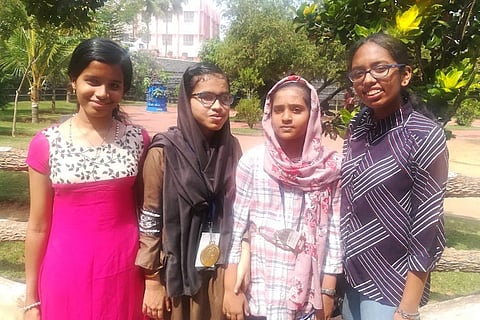

Bhadra EP, a class 9 student from Kozhikode, became one of the 19 children chosen for ‘promising projects’ at the recently concluded National Science Congress in Thiruvananthapuram. She is the only student from Kerala in the list. As many as 1,200 student delegates from around the world had taken part in the event.
“My project was about using fish scales to remove iron in the water. It is theoretical and not tested on water yet. We are waiting for permission,” says Bhadra.
Her findings showed that fish scales contain keratin protein, which will absorb iron. She made a filter media, calculated the time required to purify a litre of water, the dosage of fish scale needed for it, where to place it, and so on.
There were 16 other student delegates from Kerala, from different districts. They, too, had some interesting projects.
Mereena and Merin are twins studying in Class XI and hailing from Alappuzha. Their project was about using the water hyacinths that are taken out of canals and dumped on the ground. “The water hyacinths make fishing difficult, so the government spends money to remove it. But after that, these aquatic plants are thrown away, which, in turn, decays in the soil. We decided to make use of it for creating paper. Water hyacinth waste along with waste paper can create new paper,” says Mereena.
She then explains the process. “The water hyacinth and waste papers are boiled until it becomes a pulp and then mixed in water. After the water is drained, the mixture is spread on a newspaper and dried. A new paper is ready. You can save trees from being cut down to make paper as well as make use of the wasted water hyacinth,” she says.
Rinsha, a girl with visual impairment, who is studying in class 10 at a school in Malappuram, along with her classmate Arunima were also part of the Science Congress. Their project was about converting waste from a butcher shop into poultry feed. “A lot of chicken waste is dumped in our parts. Dumping it in rivers causes a lot of health hazards. Our project was to use the chicken waste as feed for poultry,” she says.
Rinsha and Arunima first fed chickens with raw chicken waste, and it killed them. “That was a learning. So then, we added some other ingredients, washed and dried the poultry waste using a washing machine dryer, ground it using a grinder, made it into pellets using a machine and finally put it in a heater. After letting it cool, we fed the chickens. It worked! When we checked the weight of the eggs produced by these chickens, it 10 grams more than normal,” Rinsha says.
Another Kozhikode student of class 6 worked on food products. Amina Lanika wanted to bring awareness about using the fast-disappearing food crops. “We have conducted surveys and interviews among our schoolmates and others. Most of them prefer bakery products to homemade dishes, cooked from food crops. So we tried making these dishes tasty by replacing some of the artificial ingredients with natural materials, like edible leaves, ‘kachil’, 14 ‘chembu’ (tapioca varieties) and so on. That worked,” Amina says.